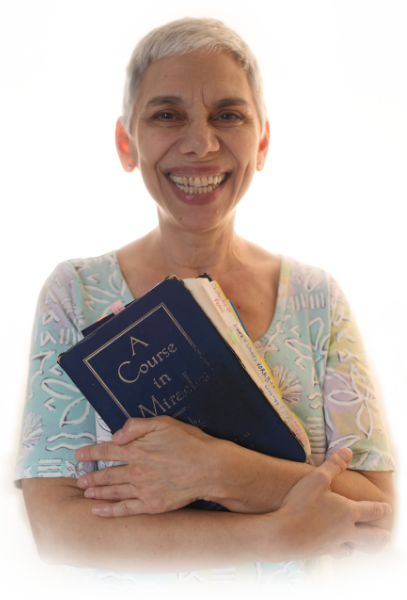08 Feb 2022 Comments Off on Lesson 39 – My holiness is my salvation.
Lesson 39 – My holiness is my salvation.
Commentary (full lesson beneath commentary)
 First we have to agree that guilt is hell. For many of us, guilt is the signal that we have a conscience, an ethical center. If we gave up guilt we might run amok, rampage, loot, steal, binge, and have orgies. Hmmm. Most of us have had the experience of doing things we know we shouldn’t even though we feel guilty 🙂 From a Course perspective, guilt keeps us believing we have separated from God by telling us we’ve done something wrong.
First we have to agree that guilt is hell. For many of us, guilt is the signal that we have a conscience, an ethical center. If we gave up guilt we might run amok, rampage, loot, steal, binge, and have orgies. Hmmm. Most of us have had the experience of doing things we know we shouldn’t even though we feel guilty 🙂 From a Course perspective, guilt keeps us believing we have separated from God by telling us we’ve done something wrong.
If we’re not guilty then we are innocent. Innocence, from a Course perspective, is an attribute of  kjhgGod’s Mind. Innocence is Oneness and Oneness is Holiness. Recognizing my holiness saves me from the misinformation the ego offers. Recognizing my holiness “returns” me to an undifferentiated State of Mind — a state of Wholeness in which sin, guilt, fear, punishment and death are impossible and do not exist.
kjhgGod’s Mind. Innocence is Oneness and Oneness is Holiness. Recognizing my holiness saves me from the misinformation the ego offers. Recognizing my holiness “returns” me to an undifferentiated State of Mind — a state of Wholeness in which sin, guilt, fear, punishment and death are impossible and do not exist.
And, of course, if my holiness is my salvation, that is how my holiness blesses the world (Lesson 37). This makes me think of wounded healers. I became a psychotherapist because I was emotionally wounded and therapy healed me beyond the personality; it led to a series of spiritual awakenings. I felt drawn to others who wanted to undergo deep self-examination.
I was, as the Course says, teaching what I wanted to learn (Introduction to the Manual for Teachers, “The course … emphasizes that to teach is to learn, so that teacher and learner are the same.” and Miracle Principle 16: “Miracles are teaching devices for demonstrating it is as blessed to give as to receive. They simultaneously increase the strength of the giver and supply strength to the receiver.”)
At some point, this phrase was given to me, “Amy teaches self-awareness which leads to Self-Awareness. God takes it from there.” This teaching is an unlearning; it is a dis-identifying with the person; a “learning” to not take ourselves and others personally. If you’re interested, read: How to Take Yourself Less Personally
LESSON 39
My holiness is my salvation.
If guilt is hell, what is its opposite? Like the text for which this workbook was written, the ideas used for the exercises are very simple, very clear and totally unambiguous. We are not concerned with intellectual facts nor logical toys. We are dealing only in the very obvious, which has been overlooked in the clouds of complexity in which you think you think.
If guilt is hell, what is its opposite? This is not difficult, surely. The hesitation you may feel in answering is not due to the ambiguity of the question. But do you believe that guilt is hell? If you did, you would see at once how direct and simple the text is, and you would not need a workbook at all. No one needs practice to gain what is already his.
We have already said that your holiness is the salvation of the world. What about your own salvation? You cannot give what you do not have. A savior must be saved. How else can he teach salvation? Today’s exercises will apply to you, recognizing that your salvation is crucial to the salvation of the world. As you apply the exercises to your world, the whole world stands to benefit.
Your holiness is the answer to every question that was ever asked, is being asked now, or will be asked in the future. Your holiness means the end of guilt, and therefore the end of hell. Your holiness is the salvation of the world, and your own. How could you to whom your holiness belongs be excluded from it? God does not know unholiness. Can it be He does not know His Son?
A full five minutes are urged for the four longer practice periods for today, and longer and more frequent practice sessions are encouraged. If you want to exceed the minimum requirements, more rather than longer sessions are recommended, although both are suggested.
Begin the practice periods as usual, by repeating today’s idea to yourself. Then, with closed eyes, search out your unloving thoughts in whatever form they appear; uneasiness, depression, anger, fear, worry, attack, insecurity and so on. Whatever form they take, they are unloving and therefore fearful. And so it is from them that you need to be saved.
Specific situations, events or personalities you associate with unloving thoughts of any kind are suitable subjects for today’s exercises. It is imperative for your salvation that you see them differently. And it is your blessing on them that will save you and give you vision.
Slowly, without conscious selection and without undue emphasis on any one in particular, search your mind for every thought that stands between you and your salvation. Apply the idea for today to each of them in this way:
My unloving thoughts about ____________ are keeping me in hell.
My holiness is my salvation.
You may find these practice periods easier if you intersperse them with several short periods during which you merely repeat today’s idea to yourself slowly a few times. You may also find it helpful to include a few short intervals in which you just relax and do not seem to be thinking of anything. Sustained concentration is very difficult at first. It will become much easier as your mind becomes more disciplined and less distractible.
Meanwhile, you should feel free to introduce variety into the exercise periods in whatever form appeals to you. Do not, however, change the idea itself as you vary the method of applying it. However you elect to use it, the idea should be stated so that its meaning is the fact that your holiness is your salvation. End each practice period by repeating the idea in its original form once more, and adding:
If guilt is hell, what is its opposite?
In the shorter applications which should be made some three or four times an hour and more if possible, you may ask yourself this question, repeat today’s idea, and preferably both. If temptations arise, a particularly helpful form of the idea is:
My holiness is my salvation from this.
Let’s practice together! Watch and listen to Amy reading each ACIM Lesson on Youtube. Also, check out Workin’ the Workbook, Amy’s online class which supports the ACIM Workbook practice.


Connect with Amy